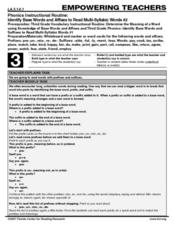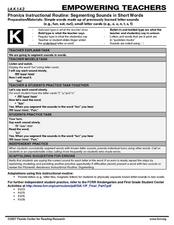Curated OER
Listening Comprehension: Retell Main Events of a Story
Story retell is a very important skill. Little learners use a story map and a previously heard story to walk through the retell and story sequencing process. They complete this activity as a whole class and then on their own.
Curated OER
Comprehension: Answering Questions then Rereading the Text to Identify Details in Support of the Answers
Even first graders can be exposed to good reading strategies and comprehension skills. The teacher demonstrates how to read informational text, look at the questions, reread the text, locate answer, then locate supporting details to...
Curated OER
Comprehension: Create a Summary from a Narrative Text
If your class can sequence events in a story, are pretty good at retell, and can identify the main point, they are probably ready for reading comprehension through summarizing. This instructional activity provides a teacher's script that...
Curated OER
Comprehension: Create a Summary from an Expository Text
Children can learn to analyze expository or informational texts at nearly any age. This scaffolded and scripted resource provides teachers with the support needed to facilitate a thoughtful lesson plan on summarizing informational text...
Curated OER
Making an Inference from an Implied Message Within a Text
Show your scholars that they make inferences every day and might not even know it. Through scaffolded instruction, they break down the process of drawing information from context. Using example sentences and didactic questioning,...
Curated OER
Comprehension: Identify Cause and Effect Relationships in Text
Third graders and their teacher work together to understand cause and effect relationships in texts. The I do, we do, you do method is used as learners discuss and determine the cause and effect relationships found in several short...
Curated OER
Comprehension: Identify cause and effect relationship in text
I do, we do, you do is the method and delivery of this lesson on cause and effect relationships in text. Second grade readers work with their teacher, then their peers, and finally on their own to read, identify cause and relationship,...
Curated OER
Comprehension: Compare and Contrast Topics in Two Texts
A scripted lesson can be a big help for new teachers. This fully scripted three-day learning activity provides teachers with the means to demonstrate how to compare and contrast two topics in two texts. Learners will work as a class to...
Curated OER
Compare and Contrast Two Settings in One Text
Look for the signal words! Scholars get both instruction and practice comparing and contrasting. Although it is completely scripted, it can also serve as a detailed outline. Demonstrate this as you read a passage (included) and search...
Curated OER
Comprehension Instructional Routine: Sequence of Events in Text
If you're looking for a detailed instructional activity on event sequencing from informational text, you've found it. There is an entire script for you to draw from as you explore order of events and sequence words. Scaffolding is key...
Curated OER
Vocabulary Instructional Routine: Multiple Meaning Words in Context
Tackle multiple-meaning words with your youngsters using this scaffolded instructional activity which features a detailed script. Begin with the word shoulder, using context clues to help scholars understand the meaning. Next, they...
Curated OER
Base Words and Prefixes
Once your second graders grasp base words and prefixes, challenge them with this visual word meaning activity. They watch you model it before engaging in guided practice. Use these word cards focused on the prefix re to help your...
Curated OER
Vocabulary: Make Connections with New Vocabulary
Connecting meaning to a given word via image or sentence can really help learners build their vocabulary and in turn enhance their reading ability. The class constructs a chart where they define each new vocabulary word, come up with an...
Curated OER
Reading Text with Appropriate Phrasing and Proper Expression
Practice reading with expression and appropriate phrasing with a scaffolded lesson. There is a detailed script here for you, but you could easily use it simply as an outline. Begin by modeling effective reading by displaying a large-text...
Curated OER
Phonics: Words with More Than One Syllable (CV/C) Rule A
Knowing basic phonics rules can help learners increase their reading accuracy, pronunciation, and spelling. Third graders practice breaking or chunking words based on the cv/c syllable rule. They take note of where to break each word,...
Curated OER
Identify Base Words and Suffixes to Read Multisyllabic Words #1
Show your scholars how adding an affix changes the entire meaning of a word; they focus on the suffix -able. You'll find a complete script here, but if you don't want to read this verbatim, use it simply as an outline. Learners watch you...
Curated OER
Phonics: Identify Base Words and Affixes to Read Multi-Syllabic Words
Encountering a new an unfamiliar word can stump even the best readers. Third graders learn how to assess the base, prefix, and suffix of words to help them determine its meaning. The class works together to go over a series of common...
Curated OER
Romantic Period in Music, Art, and Literature
“Romanticism aims at enlarging experience by exploring the real.” This excerpt from Jacques Barzun’s From Dawn to Decadence introduces a PowerPoint that examines the characteristics of and the major figures in music, art, and literature...
Curated OER
Phonemic Awareness: Syllables
Count the syllables in your name, now count the syllables in your friend's name. Kids count syllables as they clap out and segment words. This activity is done as a whole class and has the potential of being highly engaging. The engaging...
Curated OER
Phonemic Awareness: Phoneme Blending
This resource is more of a suggestion than a full lesson. It explains how young pre-readers can work with their teacher to practice blending phonemes to make words. The class watches the teacher as she says and orally segments a word...
Curated OER
Phonemic Awareness: Blending
First graders listen closely as their teacher sounds out a variety of words, one phoneme at a time. They then practice blending sounds to create words on their own. Tip: While you sound out words have your class write down each phoneme...
Curated OER
Phonics: Segmenting Words with two or three phonemes
Kindergarteners build phonemic awareness by segmenting words with two or three phonemes. As the teacher says each word, the kids put up a finger for each phoneme they hear. This can also be done with manipulative such as blocks or tally...
Curated OER
Phonemic Awareness: Segmenting
You ever feel like your going in circles? Because this lesson seems very much like others I've seen. First graders put up a finger as they count each phoneme the teacher emphasises as she says a series of words.
Curated OER
Phonics: Segmenting Sounds in Short Words
F-u-n spells fun. It is a simple word that little learners can sound out as they build phonemic awareness and those early reading skills. This short scripted lesson provides teachers with the basics for teaching how to sound out words.
Other popular searches
- Et Word Family
- Oldfather Et. Al
- System Et
- Et Spelling Pattern
- Arrangement Et
- Et Extraterrestrial
- Rhyme Pattern Et
- Et the Movie
- Science Fiction Films Et
- Et the Extraterrestrial
- Et Ending
- Led Et

























